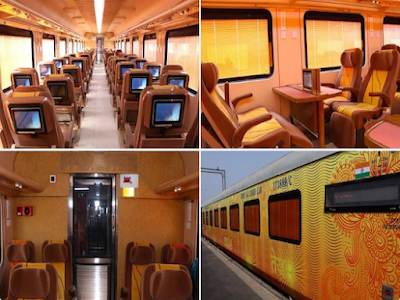Indian Railways
Indian Railways
Indian Railways (IR) is a statutory agency that operates India's national railway system and is owned by the Ministry of Railways, Government of India. It administers the world's fourth-largest national railway system, with a total route length of 67,956 kilometres (42,226 mi) as of 31 March 2022. As of 1 April 2022, 52,247 km (32,465 mi) or 83% of all broad-gauge routes are electrified with 25 kV 50 Hz AC electric traction.
History of Indian Railways:
In 1836-1837, the country's first transport train, the Red Hill Railway (constructed by Arthur Cotton to transport granite for road construction), traveled from Red Hills to the Chintadripet bridge in Madras.
Indian Railways has a history that spans back over 160 years. The first passenger train operated between Bori Bunder (Bombay) and Thane, a distance of 34 kilometres, on April 16, 1853. It had thirteen carriages and was powered by three locomotives named Sahib, Sultan, and Sindh.
Luxury Trains of Indian Railways:
There are seven luxury trains in India, which are managed by Indian Railways and the IRCTC: Maharajas' Express, Palace on Wheels, The Deccan Odyssey, Golden Chariot, Royal Rajasthan on Wheels, Royal Orient Train, and Fairy Queen Express.
Future of Indian Railways:
- Formulate strategies based on both operational capacities and commercial policy initiatives to increase modal share of the Railways in freight to 45%.
- Reduce transit time of freight substantially by increasing average speed of freight trains to 50Kmph.
- As part of the National Rail Plan, Vision 2024 has been launched for accelerated implementation of certain critical projects by 2024 such as 100% electrification, multi-tracking of congested routes, upgradation of speed to 160 kmph on Delhi-Howrah and Delhi-Mumbai routes, upgradation of speed to 130kmph on all other Golden Quadrilateral-Golden Diagonal (GQ/GD) routes and elimination of all Level Crossings on all GQ/GD route.
- Identify new Dedicated Freight Corridors.
- Identify new High Speed Rail Corridors.
- Assess rolling stock requirement for passenger traffic as well as wagon requirement for freight.
- Assess Locomotive requirement to meet twin objectives of 100% electrification (Green Energy) and increasing freight modal share.
- Assess the total investment in capital that would be required along with a periodical break up.
- Sustained involvement of the Private Sector in areas like operations and ownership of rolling stock, development of freight and passenger terminals, development/operations of track infrastructure etc.





Comments
Post a Comment